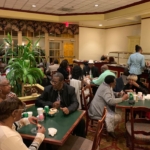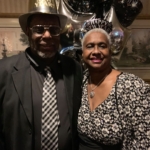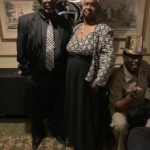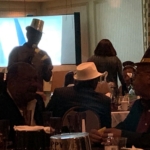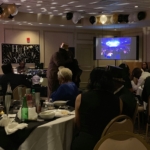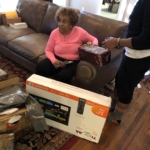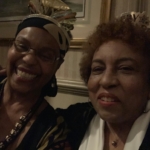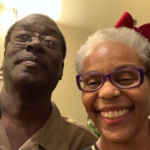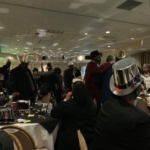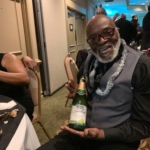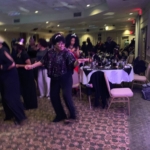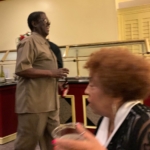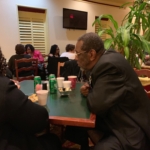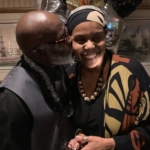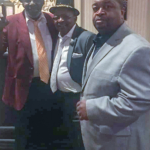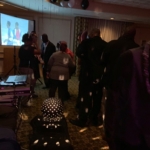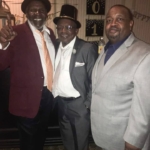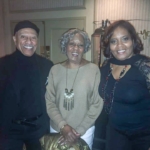Life in the shadow of industry – Newtown

Neighbors at Odds: The Haze Over Newtown
This is the first of a series of stories over three Sundays focusing on the issues of the Newtown community nestled amid industry in Gainesville’s southside. Today, we look at the everyday lives of Newtown residents. Future stories will look at the issue from the perspective of surrounding industries and focus on the government agencies whose decisions directly impact the lives of residents and businesses.
By Ashley Fielding [email protected] POSTED Dec. 6, 2009 12:02 a.m. 5 Images 1 Video 1 video in Multimedia. Just after daybreak, birds begin singing near the houses on Desota Street as they do anywhere else in Gainesville.
But here, they must compete with a percussion of beeping backhoes, droning conveyor belts and incessant industrial fans. On cue, scrap metal crashes like cymbals.
This melody plays only on the south side of Jesse Jewell Parkway. In a neighborhood where a grain mill towers over “green space,” next-door neighbors crush cars and chemically process soybeans.
Newtown is not your normal neighborhood; Imatean Childers was warned. When Childers moved next door to her niece, Peggy Brown, in Newtown, Brown cautioned Childers about the dust on Desota Street. “She was right,” Childers said, stopping for a moment from her gutter sweeping. After nearly a lifetime in the community, Brown, 61, claims she can “just about tell time” by the noises coming from the surrounding industries. But dust is Browns biggest complaint.
“You dust every day. You dust every day,” Brown said. “If you gonna live in the house, you have to dust every day. … I think every lady on this street will tell you, we are constantly dusting. Thats just the way it is up here.”
The way it is in Newtown, residential properties share boundaries with heavy industrial sites. Railcars make up the bulk of the traffic, and on hot days, the smell of soybean and grain processing is inescapable.
Such is life in the shadow of industry a reality that is at the least a nuisance, but that some residents fear is killing them.
By Ashley Fielding [email protected] POSTED Dec. 6, 2009 12:02 a.m. 5 Images 1 Video 1 video in Multimedia. Just after daybreak, birds begin singing near the houses on Desota Street as they do anywhere else in Gainesville.
But here, they must compete with a percussion of beeping backhoes, droning conveyor belts and incessant industrial fans. On cue, scrap metal crashes like cymbals.
This melody plays only on the south side of Jesse Jewell Parkway. In a neighborhood where a grain mill towers over “green space,” next-door neighbors crush cars and chemically process soybeans.
Newtown is not your normal neighborhood; Imatean Childers was warned. When Childers moved next door to her niece, Peggy Brown, in Newtown, Brown cautioned Childers about the dust on Desota Street. “She was right,” Childers said, stopping for a moment from her gutter sweeping. After nearly a lifetime in the community, Brown, 61, claims she can “just about tell time” by the noises coming from the surrounding industries. But dust is Browns biggest complaint.
“You dust every day. You dust every day,” Brown said. “If you gonna live in the house, you have to dust every day. … I think every lady on this street will tell you, we are constantly dusting. Thats just the way it is up here.”
The way it is in Newtown, residential properties share boundaries with heavy industrial sites. Railcars make up the bulk of the traffic, and on hot days, the smell of soybean and grain processing is inescapable.
Such is life in the shadow of industry a reality that is at the least a nuisance, but that some residents fear is killing them.
History speaks for itself
The issues surrounding Newtown are decades old. For 73 years, residents have watched industry after industry some of them among the countys top polluters move in next door.
It is a predicament Nik Heynen, a professor of geography at the University of Georgia, attributes to the “spatial legacy of racism in Gainesville.” “Going way back, some things that were done continue to have an effect on peoples every day lives,” Heynen said. “…Well-intended people could have a healthy debate about the role of racism in todays Gainesville… I think history speaks for itself.” Faye Bush moved to Newtown in 1948, when the streets were dirt, the houses had no porches and segregation was the way of the world.
The homes were built atop an old landfill east of Athens Street in the years immediately after the 1936 tornado to serve as the “New Town” for black families displaced by the disaster. “It wasnt anything but the land over here,” Bush said. “It wasnt no factories or anything over here, just the houses.”
And then came the industry. Though city zoning maps from as early as 1915 slated the areas surrounding Newtown for “suburban industrial” development, residents say not until 1954, when Purina built a mill off Athens Street, did industrial development really occur.
Five years after Purina, Prestolites Leece-Neville division opened up a starter motor production plant. Then came Cargills soybean processing facility and, soon after, a scrap-metal recycling business.
“When they first came in, we looked at it as a job for our people, so we didnt pay it that much attention until it had gotten so bad,” Bush said. “… We dealt with it. It wasnt OK, we didnt know anything about what kind of exposure it could have on you, because we didnt know anything about it.”
Bush is president of the Newtown Florist Club, an innocuously-named organization that has become one of the states most venerable environmental justice groups.
The group formed in 1950 with an initial purpose to raise money for funeral flowers. But as residents began to feel besieged by industry, club members became community watchdogs. In 1978, the florist club petitioned the state Environmental Protection Division to force Purina to take care of sewage odors and fugitive grain dust that continually covered residents cars and homes.
And as years passed, florist club members, whose original purpose acquainted them with the causes of neighbors deaths, began to notice a trend in their neighborhood.
“We realized we were buying so many flowers,” Bush said. A club-sponsored survey of Desota Street residents in 1990 found that neighbors shared similar types of cancers and respiratory problems. Though the study was unscientific, it prompted the state health department to look into the matter. Later that year, officials from the state Department of Human Resources confirmed the higher rate of throat and mouth cancers in the neighborhood. But an investigation by Thomas McKinley, an environmental epidemiologist from the state office of epidemiology, attributed the rate of cancers to a lifestyle of smoking and drinking, according to a report he compiled for then-U.S. Rep. Ed Jenkins.
Outraged residents refuted McKinleys conclusion.
“We knew it wasnt true,” Bush said. “We had a lot of people that said the whole thing was fraud.” The Citizens Clearinghouse for Hazardous Wastes Center for Environmental Justice analyzed McKinleys investigation in 1993. Stephen Lester, the organizations science director at the time, called McKinleys investigation “poorly designed” and “inadequate,” according to a letter he wrote to Bush.
Today, even residents who are not acutely aware of the various chemicals coming from neighboring industries blame their illnesses on industrial pollution.
It is a predicament Nik Heynen, a professor of geography at the University of Georgia, attributes to the “spatial legacy of racism in Gainesville.” “Going way back, some things that were done continue to have an effect on peoples every day lives,” Heynen said. “…Well-intended people could have a healthy debate about the role of racism in todays Gainesville… I think history speaks for itself.” Faye Bush moved to Newtown in 1948, when the streets were dirt, the houses had no porches and segregation was the way of the world.
The homes were built atop an old landfill east of Athens Street in the years immediately after the 1936 tornado to serve as the “New Town” for black families displaced by the disaster. “It wasnt anything but the land over here,” Bush said. “It wasnt no factories or anything over here, just the houses.”
And then came the industry. Though city zoning maps from as early as 1915 slated the areas surrounding Newtown for “suburban industrial” development, residents say not until 1954, when Purina built a mill off Athens Street, did industrial development really occur.
Five years after Purina, Prestolites Leece-Neville division opened up a starter motor production plant. Then came Cargills soybean processing facility and, soon after, a scrap-metal recycling business.
“When they first came in, we looked at it as a job for our people, so we didnt pay it that much attention until it had gotten so bad,” Bush said. “… We dealt with it. It wasnt OK, we didnt know anything about what kind of exposure it could have on you, because we didnt know anything about it.”
Bush is president of the Newtown Florist Club, an innocuously-named organization that has become one of the states most venerable environmental justice groups.
The group formed in 1950 with an initial purpose to raise money for funeral flowers. But as residents began to feel besieged by industry, club members became community watchdogs. In 1978, the florist club petitioned the state Environmental Protection Division to force Purina to take care of sewage odors and fugitive grain dust that continually covered residents cars and homes.
And as years passed, florist club members, whose original purpose acquainted them with the causes of neighbors deaths, began to notice a trend in their neighborhood.
“We realized we were buying so many flowers,” Bush said. A club-sponsored survey of Desota Street residents in 1990 found that neighbors shared similar types of cancers and respiratory problems. Though the study was unscientific, it prompted the state health department to look into the matter. Later that year, officials from the state Department of Human Resources confirmed the higher rate of throat and mouth cancers in the neighborhood. But an investigation by Thomas McKinley, an environmental epidemiologist from the state office of epidemiology, attributed the rate of cancers to a lifestyle of smoking and drinking, according to a report he compiled for then-U.S. Rep. Ed Jenkins.
Outraged residents refuted McKinleys conclusion.
“We knew it wasnt true,” Bush said. “We had a lot of people that said the whole thing was fraud.” The Citizens Clearinghouse for Hazardous Wastes Center for Environmental Justice analyzed McKinleys investigation in 1993. Stephen Lester, the organizations science director at the time, called McKinleys investigation “poorly designed” and “inadequate,” according to a letter he wrote to Bush.
Today, even residents who are not acutely aware of the various chemicals coming from neighboring industries blame their illnesses on industrial pollution.
All types of stories
“You hear all types of stories,” said former Newtown resident Tyrone Sims. “I just know that a lot of people here have contracted cancer, you know. My mother was one of them.”
Sims parents moved into their house on Harvey Street in 1949, shortly before industry began building a fortress around Newtown. His mother later died of liver cancer. His brother died of pancreatic cancer. And his uncle, also a Newtown resident, died of lung cancer.
Sims, now 39 and a resident of Royston, remembers the childlike awareness he had of the industries next to his neighborhood. “You could see that dust … I remember that, you know, vividly,” Sims said. “But the thing that really caught my attention, you see, I was 21 years old when my mom died. I was in college at the time,” Sims said. “And you just start noticing people dying around here. And everybody was dying of cancer; it wasnt any other illnesses … it was always cancer or lupus.”
Lupus is a chronic, autoimmune disease that can damage any part of the body. It has appeared in Newtown in more than one form. The prevalence of lupus in Newtown is approximately six times higher than the national rate, according, to a 1997 study conducted in collaboration with the Rollins School of Public Health of Emory University.
The same study found that lupus affects the men and women of Newtown equally; nationally, the disease occurs five times more frequently in females than in males. Not much is known about the cause of lupus, but researchers believe “a combination of genetics (heredity), environment, and hormones is involved,” according to the Lupus Foundation of America Web site. Newtown residents are convinced their environment is a key contributing factor. Maybe more than anyone, Jerome Whelchel believes that the environment in Newtown has an adverse effect on residents health.
Whelchel, a 55-year-old resident of Desota Street, lost his sister and his brother lupus in the 1960s and 1970s and his father died of lung cancer in 1992. His mother, Mozetta Whelchel, a former florist club member who is Bushs older sister, is currently in a nursing home with a brain tumor.
Whelchel now lives alone in his family home on Desota Street. “Im the last,” Whelchel said.
Sims parents moved into their house on Harvey Street in 1949, shortly before industry began building a fortress around Newtown. His mother later died of liver cancer. His brother died of pancreatic cancer. And his uncle, also a Newtown resident, died of lung cancer.
Sims, now 39 and a resident of Royston, remembers the childlike awareness he had of the industries next to his neighborhood. “You could see that dust … I remember that, you know, vividly,” Sims said. “But the thing that really caught my attention, you see, I was 21 years old when my mom died. I was in college at the time,” Sims said. “And you just start noticing people dying around here. And everybody was dying of cancer; it wasnt any other illnesses … it was always cancer or lupus.”
Lupus is a chronic, autoimmune disease that can damage any part of the body. It has appeared in Newtown in more than one form. The prevalence of lupus in Newtown is approximately six times higher than the national rate, according, to a 1997 study conducted in collaboration with the Rollins School of Public Health of Emory University.
The same study found that lupus affects the men and women of Newtown equally; nationally, the disease occurs five times more frequently in females than in males. Not much is known about the cause of lupus, but researchers believe “a combination of genetics (heredity), environment, and hormones is involved,” according to the Lupus Foundation of America Web site. Newtown residents are convinced their environment is a key contributing factor. Maybe more than anyone, Jerome Whelchel believes that the environment in Newtown has an adverse effect on residents health.
Whelchel, a 55-year-old resident of Desota Street, lost his sister and his brother lupus in the 1960s and 1970s and his father died of lung cancer in 1992. His mother, Mozetta Whelchel, a former florist club member who is Bushs older sister, is currently in a nursing home with a brain tumor.
Whelchel now lives alone in his family home on Desota Street. “Im the last,” Whelchel said.
Its not regular dust
Brown, who moved to Desota Street when she was 12, now has chronic bronchitis; her mother had asthma. She attributes both problems to Newtowns air quality.
Delinda Luster, a 63-year-old Desota Street resident, says dust sometimes blankets the area and aggravates her allergies. Lusters doctor has advised her to stop opening windows and hanging clothes outside, she said. “It makes you feel dirty,” Luster said. “… I cant stand here and say where its coming from, but its not regular dust.” Luster says that, sometimes, she feels like she can taste the dust.
“Sometimes, if you stay outside, when you come back in, you clean out your nose, and youd be surprised at what you got out of your nose,” Luster said. “No, it couldnt be pollen. In the wintertime, pollens not out there.” More than once, but as recently as 2007, residents suspicions about dust problems were confirmed by state officials. The state Environmental Protection Division fined the nearby grain mill owned by Land O Lakes Purina $11,000 for problems with the facilitys record-keeping and for malfunctioning equipment, according to EPD enforcement records.
The problems caused grain dust from the mill to continually “spew out” in the community, according to Ela Orenstein, an air quality and environmental justice attorney for GreenLaw.
The 2007 enforcement order from EPD required Purina to repair the mill, but residents say dust still is occasionally a problem. Edith Slaughters home at the top of Emily Street is further removed from the Purina mill than her Desota Street neighbors. She says noise isnt usually a problem on the hill, but dust can be. “I dont think we get a whole lot up here,” Slaughter said. “But I do see it on my car, so I know if its on my car, its getting in me.” Nothing but Newtown Ever since industries moved in, Blondine Summerour, 71, said she is regularly awakened by the sounds of industries near to her Desota Street home. “Its enough that we live near a railroad track and a junk yard,” Summerour said. “You can imagine I dont know any other people that live where theres a subdivision or a community near a mill, no kind of industry. Nothing but Newtown. So it was a mistake by them building it in the first place.”
Orenstein, who represents the Newtown Florist Club along with the nonprofit environmental justice firm GreenLaw, agrees that Newtowns situation is unique. “The fact that the tornado came through, and that the African-American community was literally relocated on top of what used to be a municipal solid waste landfill and then was surrounded by industry theres such intention in that story that you dont find in all stories,” Orenstein said.
But there are communities like Newtown all across the state, Orenstein said. “Its a historic community of color, and theyre dealing with a disproportionate burden of pollution,” Orenstein said. “And that is not necessarily a unique story in Georgia.” The persistence and the cohesion of the Newtown Florist Club has attracted a number of academics to the community over the last decade.
“Their ability to sort of see a cohesive vision is really amazing to me,” said Jamie Baker Roskie, an attorney with the University of Georgias Land Use Clinic that works with the florist club. “They understand that … the scrap yards not their only problem; there are things that they need to do in terms of development of and cohesion of their own neighborhood in order to make their lives better, and theyve always shown a willingness to do that.”
Roskie has organized a team of researchers to tackle the many issues facing Newtown, including Heynen. Together, the group hopes to accurately assess the environmental health of Newtown and carve out a more livable community. But attainment of that goal will only be possible if the group can work in cooperation with local government and state environmental regulators, Bush said. She hopes that government officials will place tighter regulations on noise and air pollution, and she hopes to see the nearby scrap-metal recycling yard become green space.
“I think as long as weve suffered in this community that we should have some green areas, walking trails for our people over here, and thats one thing that I would like to see,” Bush said. Earlier this year, Roskie proposed two ordinances that would regulate noise and dust emissions in the city, but Gainesville officials have yet to act. In the mean time, researchers like Hynen are monitoring air quality conditions and testing the soil to see if it is safe for residents to start a community garden near Desota Park. The garden is the next step in a beautification effort that the Newtown Florist Club initiated earlier this year, Bush said. And more than anything, its a sign that Newtown residents are committed to a better quality life in their community, Heynen said.
“I grew up in this neighborhood, I mean, this is what made me, thats why I come back here,” Sims said. “… Everything that I have achieved, everybody in this community is a part of.”
“Thats where I got all my values from, Newtown, and I aint going to let everybody run me out,” Sims said. “Thats what they want
Delinda Luster, a 63-year-old Desota Street resident, says dust sometimes blankets the area and aggravates her allergies. Lusters doctor has advised her to stop opening windows and hanging clothes outside, she said. “It makes you feel dirty,” Luster said. “… I cant stand here and say where its coming from, but its not regular dust.” Luster says that, sometimes, she feels like she can taste the dust.
“Sometimes, if you stay outside, when you come back in, you clean out your nose, and youd be surprised at what you got out of your nose,” Luster said. “No, it couldnt be pollen. In the wintertime, pollens not out there.” More than once, but as recently as 2007, residents suspicions about dust problems were confirmed by state officials. The state Environmental Protection Division fined the nearby grain mill owned by Land O Lakes Purina $11,000 for problems with the facilitys record-keeping and for malfunctioning equipment, according to EPD enforcement records.
The problems caused grain dust from the mill to continually “spew out” in the community, according to Ela Orenstein, an air quality and environmental justice attorney for GreenLaw.
The 2007 enforcement order from EPD required Purina to repair the mill, but residents say dust still is occasionally a problem. Edith Slaughters home at the top of Emily Street is further removed from the Purina mill than her Desota Street neighbors. She says noise isnt usually a problem on the hill, but dust can be. “I dont think we get a whole lot up here,” Slaughter said. “But I do see it on my car, so I know if its on my car, its getting in me.” Nothing but Newtown Ever since industries moved in, Blondine Summerour, 71, said she is regularly awakened by the sounds of industries near to her Desota Street home. “Its enough that we live near a railroad track and a junk yard,” Summerour said. “You can imagine I dont know any other people that live where theres a subdivision or a community near a mill, no kind of industry. Nothing but Newtown. So it was a mistake by them building it in the first place.”
Orenstein, who represents the Newtown Florist Club along with the nonprofit environmental justice firm GreenLaw, agrees that Newtowns situation is unique. “The fact that the tornado came through, and that the African-American community was literally relocated on top of what used to be a municipal solid waste landfill and then was surrounded by industry theres such intention in that story that you dont find in all stories,” Orenstein said.
But there are communities like Newtown all across the state, Orenstein said. “Its a historic community of color, and theyre dealing with a disproportionate burden of pollution,” Orenstein said. “And that is not necessarily a unique story in Georgia.” The persistence and the cohesion of the Newtown Florist Club has attracted a number of academics to the community over the last decade.
“Their ability to sort of see a cohesive vision is really amazing to me,” said Jamie Baker Roskie, an attorney with the University of Georgias Land Use Clinic that works with the florist club. “They understand that … the scrap yards not their only problem; there are things that they need to do in terms of development of and cohesion of their own neighborhood in order to make their lives better, and theyve always shown a willingness to do that.”
Roskie has organized a team of researchers to tackle the many issues facing Newtown, including Heynen. Together, the group hopes to accurately assess the environmental health of Newtown and carve out a more livable community. But attainment of that goal will only be possible if the group can work in cooperation with local government and state environmental regulators, Bush said. She hopes that government officials will place tighter regulations on noise and air pollution, and she hopes to see the nearby scrap-metal recycling yard become green space.
“I think as long as weve suffered in this community that we should have some green areas, walking trails for our people over here, and thats one thing that I would like to see,” Bush said. Earlier this year, Roskie proposed two ordinances that would regulate noise and dust emissions in the city, but Gainesville officials have yet to act. In the mean time, researchers like Hynen are monitoring air quality conditions and testing the soil to see if it is safe for residents to start a community garden near Desota Park. The garden is the next step in a beautification effort that the Newtown Florist Club initiated earlier this year, Bush said. And more than anything, its a sign that Newtown residents are committed to a better quality life in their community, Heynen said.
“I grew up in this neighborhood, I mean, this is what made me, thats why I come back here,” Sims said. “… Everything that I have achieved, everybody in this community is a part of.”
“Thats where I got all my values from, Newtown, and I aint going to let everybody run me out,” Sims said. “Thats what they want



